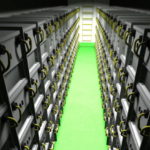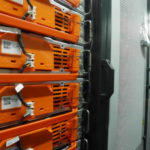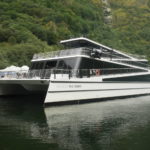It might just be a sliver of the market today, with only around 200 ships out of the global fleet that have batteries installed, but is electrification on the horizon in shipping?
All electric ships and hybrid ships with energy stored in large batteries with optimized power control can significantly reduce fuel[ds_preview] costs, maintenance and emissions. Additionally, increased ship responsiveness and improved robustness and safety in critical situations are obtained. Power generation units can be smaller or fewer and optimized for a more average (rather than peak) load, and thereby reducing investment costs. Batteries can store energy harvested from waste heat recovery, regenerative braking of cranes and renewable energy. Additionally, they can improve propulsion systems based on LNG and other environmental friendly fuels and improve the performance of emission abatement technologies.
Batteries, chemistry and cost
Lithium-ion chemistry (Nickel Cobalt Manganese (NCM) is the clear market leader in the sector at the moment due to its balance of safety, cost, energy density, power, and lifetime. It is likely to remain the key technology in maritime applications over the next few years. NCM battery prices are decreasing rapidly and performance is increasing primarily driven by demand in the automotive and consumer electronics industries. In shipping, however, the additional requirements for safety testing and maritime packaging result in a higher price.
There are other options, however, and for shipping’s needs – high performance, greater safety, and reduced degradation – lithium-titanate batteries (LTO) can be an attractive option for many applications. Iron-phosphate (LFP) also presents benefits which can be advantageous. Over the longer term, solid state electrolyte systems could break through into the market, while options such as lithium-air still have significant barriers to overcome, and are not likely to become commercially viable in the next ten years.
The prices of lithium-ion battery cells have dropped and continue to drop markedly, falling by 50% in 2016 alone. Carmakers have set a price goal of 100$/kWh for lithium-ion cells by 2020, which seems to be a realistic goal. If this target is reached maritime systems could certainly benefit, although many of the additional costs of marinization will still apply. The wide range in maritime system prices is likely to remain, with different types of solutions available for the different applications.
Total battery system prices for shipping installations include both the lithium-ion battery cells themselves as well as the cost of system integration; including module construction, battery control hardware and software, power conversion electronics, thermal management, and testing. The figure below indicates trends in battery cell pricing as well as potential trajectories for full maritime systems (AC, including power electronics).
In some senses hybrid or electric systems do not face some of the challenges of new fuel types when it comes to infrastructure, as a battery system is essentially a device that stores DC electricity and interfaces to the electrical distribution system with standardized power electronics hardware. As such, the infrastructure required for battery systems on board ships mainly consists in providing an adequate charging grid. However, when we look at the charging itself the challenge becomes apparent. For instance, charging 1,000 kWh (approximately equivalent to 100 l of oil-based fuel) in 30 minutes requires 2,000 kW of power; while charging the same amount of energy in 10 minutes requires 6,000 kW of shore power. Such demand can represent a considerable load on the local electrical network and therefore may require additional resources. And in the case of hybrid vessels, there is no absolute requirement for a charging network to take advantage of battery systems (plug in hybrids can of course use charging stations).
On the other hand, once the electrical system has been established for a given installation, it is nominally a straightforward process to replace the batteries with a new, updated or replacement technology. This means the electrical infrastructure for battery systems can be relatively easily reused enabling a high degree of interchangeability.
Regulations
Regulations for batteries in shipping have been focused on the safety of the batteries and installations, primarily through the classification societies. DNV GL has rules that cover the use of batteries as part of a vessel’s propulsion energy in either hybrid battery or »pure« battery-driven vessels for several years now. The rules cover all aspects of their use including such safety requirements as the vessel’s arrangement and environmental controls, including temperature and ventilation, and the required location of the battery systems and associated electrical systems. In addition, the batteries on a classed vessel must be certified to the requirements in the Battery Power class rules, for which DNV GL offers a type-approval service.
The testing ground and the next generation
In Norway, a combination of government incentives, emissions regulations, and fortuitous timing – with many vessels serving on local and commuter routes due for renewal – have created ideal conditions for electrification. This means that over the next few years, some 50 vessels could be hitting the water with battery-electric or even hydrogen fueled systems.
Over the next several years, batteries will step up to the next weight class, with the construction and launch of much larger vessels in the passenger sector. In February this year, the first of two 140m hybrid cruise vessels ordered by Hurtigruten at Kleven Verft hit the water. It’s hybrid systems feature battery power to supplement auxiliary engines for peak shaving, whereby the battery responds dynamically to cover spikes in demand. This measure alone is predicted to cut fuel consumption by 20%. And the second vessel will have batteries capable of sustaining fully electric operation for 15 minutes – possibly more.
Last year as well another milestone was reached with the order of »Color Hybrid«. With a length of 160m, and a 2,000 passenger, 500 vehicles capacity, »Color Hybrid« will be the largest plug-in hybrid ferry after its planned delivery in 2019. Under construction at Norwegian shipyard Ulstein Verft the vessel will operate between Norway and Sweden. As a plug-in hybrid, »Color Hybrid’s« batteries will be recharged either by means of a power cable with green electricity from shore, or by the ship’s onboard generators and its bank of 4 MWh to 5 MWh batteries will deliver sufficient power to sail, silently and with zero CO2, NOx and SOx emissions for 30 minutes on full electric power.
The state of play in 2018
Batteries are still not a mainstream option for shipping – but the arguments for using electric or hybrid technologies are growing stronger every day. The typical use case for a hybrid or electric vessel is one that is typically operating in limited geographical areas on relatively short routes with frequent port calls. But over the next few years we expect hybrid technology, using batteries alongside traditional engines, to quickly grow and to encompass the majority of new vessels; particularly as more companies are gaining experience and new benefits and opportunities are being uncovered. And as the technology advances and stricter emissions regulations loom on the horizon, battery and hybrid solutions will become an increasingly interesting option for even larger vessels.
Benjamin Gully





















